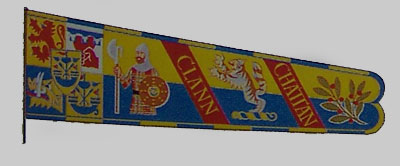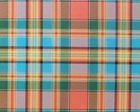- Clan Names: Chattan
- Clan Motto: Touch not the cat bot a glove. - bot = without
- Clan Chief: Duncan Alexander Mackintosh of Torcastle,
the 31st Chief of Clan chattan
- Clan Tartan :
- Clan links : Clan Chattan
- Clan links :
- Clan links :
Clan History
This clan is actually a powerful confederation of smaller highland families, who in the 14th century, gathered together for protection.
The exact origins are a bit cloudy with the earliest documentary evidence showing in the time of King Malcolm 2nd who ruled from 1005-1034. This indicates a chieftain of the Clan Chattan held lands at Glenloy and Loch Arcaig in Lochaber and had established a seat at Tor Castle.
Records show that in 1291 Eva, daughter of the Dougall Dall 6th Clan Chief,
married an Angus 6th Lord of Mackintosh, who then through the marriage became the 7th Captain of Clan Chattan.
This started a line of Mackintoshes Chiefs as Clan Captains and the history of the two clans starts to get a bit inter-twined.
Angus the sixth, fought alongside Robert the Bruce and in 1319 was rewarded with lands at Badenoch, taken from the unfortunate Comyns (Cummings). Angus, to mark his new status, moved the family seat to Rothiemurchus in Badenoch.
There was a long standing feud between the Chattan's/Mackintosh's and the Cameron clan over land boundaries and Tor Castle. With major Clan Battles in 1337 and 1370. This had been brewing and flaring up for so long that in 1396 King Robert 3rd decided to intervene. He arranged a test by Judicial Combat which was set to end the feud once and for all.
Stands were erected on the North Inch at Perth two teams were selected, rules were set and they were basically to fight to the death the winner getting Royal approval and the loser to back down on all claims.
There are lots of different versions of how many, what weapons and such, Walter Scott even included his version at the end of his "Maid of Perth". The facts that all agree on are that Chatten came out on top and it was so unexpectedly bloody and violent that the Royal entourage were shocked and distressed.
The feud, lasted another 150 years.
King James 5th had an oppressed upbringing. He inherited his crown as an infant and was manipulated by his regents and mentors even at one stage being locked up for two years by his step-uncle Archibald Douglas who was abusing his position of power. In 1528 James finally broke free and sought retribution. He was now out to prove he was his own man.
(just setting the scene - the Chattan's had nothing to do with the Kings upbringing)
In 1526 Lauchlan Macintosh of Dunnachtan who was a strict and fair Chief was murdered by some of the low life that was unsettling the clan. His son and successor was still an infant and to protect and nurture him until he came of age, it was decided to to send him to his uncle the Earl of Moray.
Hector Mackintosh, the chief's illegitimate brother took command in the mean time. Hector was not in agreement with the fledgling chief being sent away and with a band of men set out to bring him back. They attacked the castle and lands of the Earl of Moray and invaded the lands of the Ogilvies killing 24 of them. This was to carry on for the next two years.
In 1528 King James raised a savage commission of Fire and Sword in 1528 and gave his half brother James Earl of Moray a large body of men to carry it out. He was to punish the clan for widespread disorder in Badenoch and elsewhere. It demanded the "utter extermination and destruction" of the clan and it's supporters "leaving none alive except priests, women and children" who were to be shipped across the sea to the low countries. In an effort to catch Hector 300 male prisoners were questioned and offered their freedom for information on his location but none would give it. They were all hanged one by one.
To save further loss of life Hector gave himself up and gave an oath of fealty to the King which was accepted.
In the Jacobite uprisings Clan Chattan declared for the Stuarts and suffered the consequences. At the Battle of Preston in 1715 the clan lost their bravest warriors in particular the MacGillivrays who took a high loss.
Lachlin the MacKintosh Clan Chief was captured and imprisoned until August 1716. He died in 1731 and was succeeded by William who died in 1740.
Next chief was Angus the 22nd Chief of the MacKintosh's and the 23rd Chief of the Chattan's, when Bonnie Prince Charlie landed in 1745 he was actually serving the "United Kingdom" army with the Black Watch in France. They were brought back to England and kept in the south coast to "protect against a French invasion" while the army grappled with the Jacobites. Angus's wife, a Jacobite, rallied the Confederation selecting MacGillivray of Dunmaglass as commander. He led the clan on to victory at Falkirk in 1746 and took the men to Culloden.
In 1938 Clan Chief Alfred Donald died leaving no heirs, he had nominated his successor of the MacKintoshes but not the Chattans. In 1947, it was decided, by the Lyon Court, that Duncan Alexander MacKintosh of Daviot should be granted the Arms. Which separated the two Clans with different Chiefs.
Although today the current Chief lives in Africa and the MacKintosh Clan Chief is the Confederation President.
The confederation included Clans, Clan branches or even large families with names such as: the MacBains, Cattanachs, MacPhail, MacPhersons, Mackintoshes, MacThomases, Ritchies, Farquharsons, Shaws, MacLeans of Dochgarroch, Davidsons, MacAndews, MacIntyres of Badenoch, MacQueens and the MacGillivrays.









